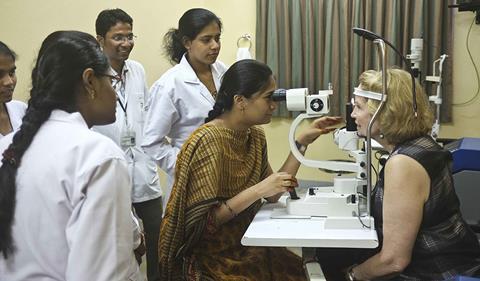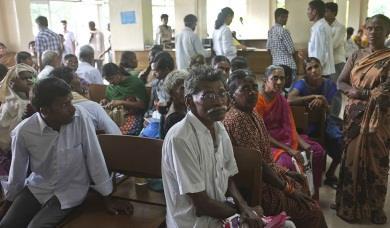In the third article in the Lessons from India series, Ajit Abraham explores the many possibilities created by compassionate clinicians.

A member of the study receives an impromptu eye health check at the LV Prasad education centre, Hyderabad
For me as a clinical leader the tour was an affirmation of the art of possibility.
‘Surgeons embrace standard work as the only way for surfacing and understanding variation to improve care’
The first and most striking lesson of the tour was that it is possible for clinicians to connect a compelling sense of social mission to an equally acute sense of “value”, representing the highest possible quality for the lowest possible cost.
Second is the crucial role of visionary, humble and compassionate clinical leadership and followership in shaping the tremendous success of organisations like Narayana Health and LV Prasad Eye Institute.
What’s right for the patient
Third, the clear ownership by surgeons of the segmentation of care in terms of doing the right type of operation in the right setup for the right patient.
The surgeons embrace standard work not as restrictive, but as the only way for surfacing and understanding variation in order to improve care for specific conditions.
- Ros Roughton: how to improve care with limited resources
- Jim Easton: there’s no conflict between good care and commercial success
Fourth, the idea of “just enough”: doing what is appropriate, affordable and adequate, something we as clinicians in the NHS are too quick to dismiss as a mere developing world opportunity, often overlooking cost savings in areas where the evidence does support more affordable options.
Socially committed
Fifth, the evident surgical ownership and leadership of quality and safety.
‘There is evidence of surgical ownership and leadership of quality and safety’
A shared sense of clinical accountability through integration of continuous quality improvement by measurement of process and outcome into the daily work.
This commitment to the social mission is meshed with a vibrant openness to disruptive innovation including in technology, such as basing the entire electronic medical record on the Cloud, significantly reducing IT costs and the use of telemedicine for rural outreach.
Above all, the willingness to not get bogged down in the quest for a perfect solution, instead relentlessly innovate, test, implement, improve and sustain.

Wise words
In the words of Ashutosh Raguwanshi, chief executive of Narayana Health, when asked how they had achieved so much, so quickly.
He said: “Once we have determined our vision, we just start walking towards it.”
It is time the NHS started walking towards “value” for those it serves.
Ajit Abraham is consultant hepato-pancreatico-biliary surgeon and associate medical director of improvement, innovation and safety at Bart’s Health Trust. Photos by John Illingworth, policy manager at the Health Foundation
Lessons from India: how to improve care with limited resources

First dispatch from senior NHS leaders’ research trip
- 1
- 2
 Currently
reading
Currently
reading
Lessons from India: the role of tech and compassionate clinical leadership
- 4
- 5

































No comments yet